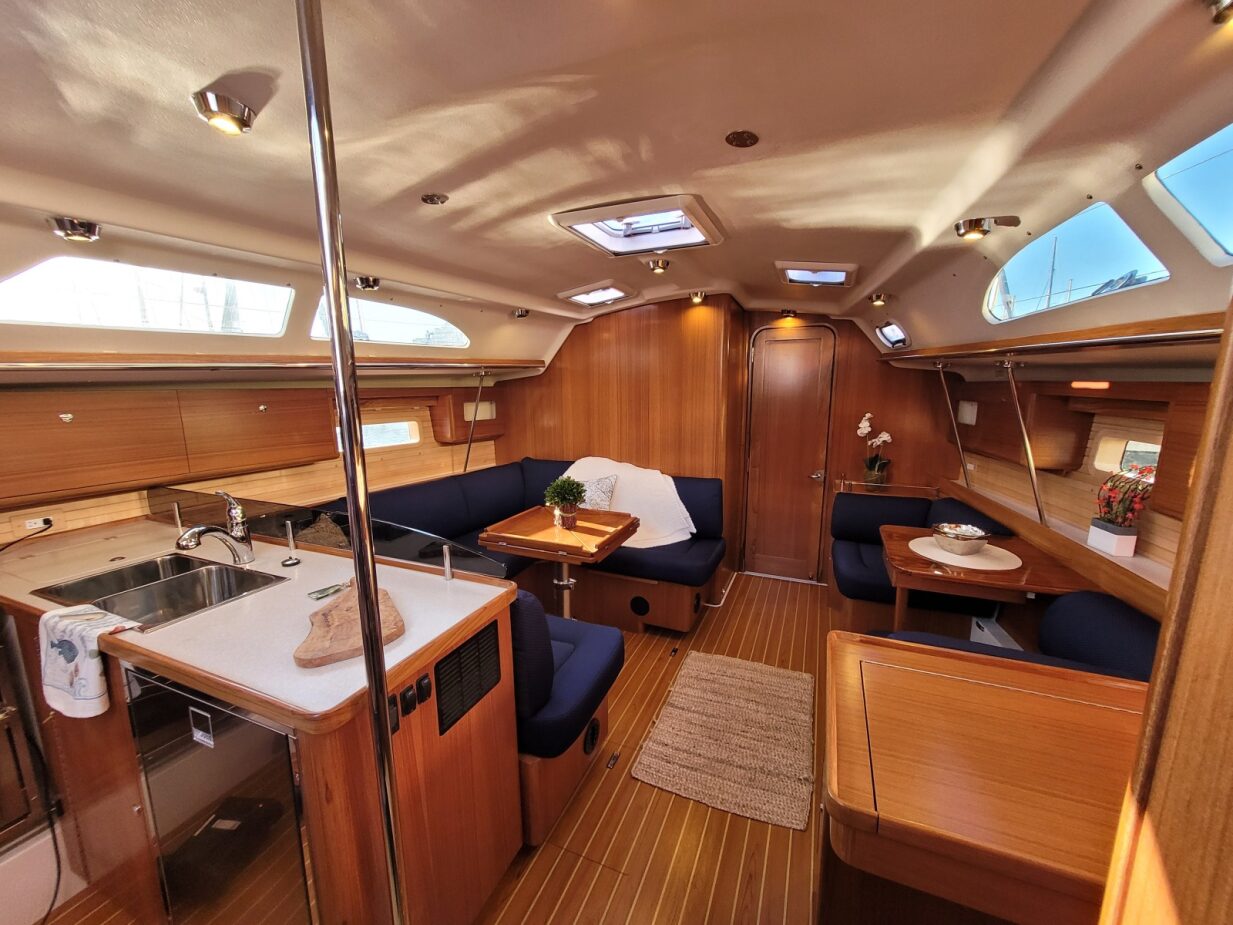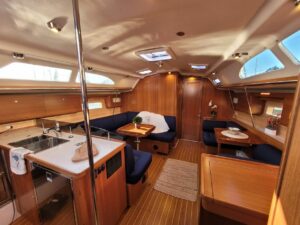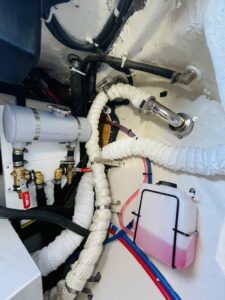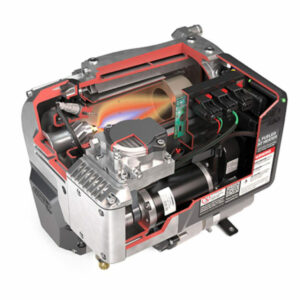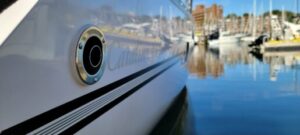Recently, Tom Cox-Rogers and the TCR Coastal Power team, in partnership with Specialty Yacht Sales, completed an install of the new Dometic ProHeat X-30 hydronic heating system aboard a 2022 Catalina 445 sailboat. With the weather chilled and blowing, Pacific Yachting found this to be a great opportunity to discuss heaters with Tom and review some of the products and installation options available to northwest boaters. Those options include not only hydronic heating, but also reverse cycle and forced air heating.
Hydronic vs Reverse Cycle
Most vessels over 30 feet that are built in the US or other countries with predominately warmer climates come equipped with reverse cycle air conditioning. The primary function of these systems is to provide cooling and air conditioning, but if needed they can offer heat.
“Reverse cycle is pretty limited on the heating front,” explained Tom. “It provides a heat source, but the quality and volume of heat is not sufficient for what boaters need on the West Coast.”
Tom estimates that reverse cycle can be anywhere from 75 to 95 percent efficient when chilling the boat, but this can drop to 20 to 40 percent efficient when heating. Of course, in parts of the world where cooling the vessel is the key objective, reverse cycle is the logical choice. Another consideration is that reverse cycle systems utilize AC as the power source. This means the vessel must be plugged into shore power or running a generator. Running a generator puts more run hours on the motor while using more diesel than alternative heating systems. When installing from scratch, one must also consider that reverse cycle systems require additional thru-hulls to pull saltwater in and discharge it overboard, which means running a potentially noisy raw-water pump.
“The heating function of reverse cycle heaters is more of a bonus that comes with an air conditioning system,” explains Tom, “but it is not something that any owner that I’ve ever run into relies on for heating—in BC anyways. It has its place in the industry, but if you’re a boater who enjoys using your vessel outside of the prime summer months, it’s common to install more efficient forced air or hydronic heating systems, even if the vessel already has reverse cycle heating. Both forced air and hydronic heaters utilize 12 or 24 VDC. This means you eliminate the need to run a generator altogether.”
Hydronic vs Forced Air Heating
Forced air systems are diesel furnaces with an internal fan that draws in cool air, heats it, and blows it out through a main duct with the ducted outlets located throughout the vessel. In contrast, hydronic heating systems use a diesel fired boiler to heat water which is then circulated via coolant hoses throughout the vessel. Each zone where heat is required has a small radiator (heat exchanger) and fan which blows the hot air into that area.
“Generally speaking,” says Tom, “you’re going to see forced air on smaller vessels—say about 35 feet and smaller—usually on sailboats where you have less cabin space to heat or less need to control the heat. It is a less efficient heat, but it is still very functional and that is why you usually see them on smaller boats.”
“While forced air systems works well for smaller vessels,” notes Tom, “by the time you get to the last portion of the ducting, the heat quality can be significantly less than within the first 10 or 15 feet from the furnace.” In addition, forced air systems don’t allow much control over the distribution of this heat. Forced air heaters have one controller (thermostat) and when you turn on the furnace, you have to have at least one duct always open, so the only control you really have is closing the louvre vents in each area, forcing the heat to a different spot. However, one big advantage of forced air is that the furnace unit is less expensive, and installation involves considerably less labour than a hydronic system. Forced air systems consist of a furnace, air intake, exhaust, electrical supply, thermostat and fuel supply. Then it is a matter of cutting the holes though the bulkheads to run your single duct and installing the vents in the appropriate areas.”
While hydronic heating is more efficient, the volume of equipment and labour is significantly higher. The advantage is that each blower is going to have close to the same quality of heat from front to back. “You do lose a bit of efficiency,” notes Tom, “because the coolant loop is going to be a little cooler by the time it reaches the last blower in the loop, but on the plus side it gives you the ability to heat a much larger area and individually customize the heat for each. For example, a blower for a larger space may be 12,000 BTU. A smaller space may only need to be 8,000 BTU while the saloon may have a combined 24,000 BTU output. On top of that, selected zones can be controlled via thermostats, all of which have the ability to call for heat, or shut the heater off, as required.”
Tom describes the process of generating heat. “When heat is called for via the thermostat, the heater will turn on and start the heating process. This begins with the coolant pump starting to circulate the coolant, and the fuel pump starting to prime and bring in diesel fuel. At this point the furnace ignites and begins to heat up internally. The coolant continues to circulate in the closed loop and becomes hotter and hotter each time it passes through the furnace. When the coolant water mixture is hot enough (anywhere from three to seven minutes depending on the system design), it will close an internal aquastat (a temperature sensitive switch) which allows power to the blower circuits (via a zone board). Once the coolant loop reaches a set temperature, the furnace shuts down, so it is not using fuel, but the pump continues to circulate the coolant. When the coolant drops below a set temperature, it turns the furnace portion back on. The initial heating cycle takes the longest. After which, the coolant is relatively hot and the system takes a lot less time to bring it up to full heat. The net result is that the hydronic heater will give you a much more intense heat. It heats up the selected area quicker and more efficiently than forced air.
Another benefit to hydronic heating is that it can be interfaced with a hot water tank in much the same way that an engine heating loop works when a vessel’s engine is running. This is a good function for sailors who must rely on running their engine to heat their hot water. With this setup, aquastats installed in the hot water tank will call for the heating system to come on and act as a separate zone. When this happens, none of the blowers get power, but instead, the hydronic system heats up the water. And of course, in most cases, hot water can also be generated when the vessel is connected to shore power. At the same time, a heat exchanger can be installed in line with the engine coolant loop, thus allowing the engine to continue to heat the hot water tank if needed.
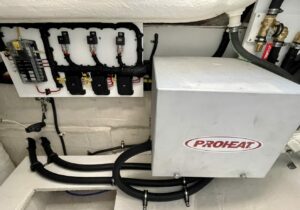
Installation
There are numerous forced air and hydronic systems on the market. They include Dometic, Espar, Webasto, Kabola and ITR Hurricane. “Traditionally, in my mind, Espar has been the highest quality,” says Tom, “but recently, in partnership with Western Marine and Specialty Yacht Sales, we installed the Dometic ProHeat X-30. Initial feedback from our technicians is that the product is designed and built well. I’m sure other people will swear up and down by other brands, but I can only advise on my preferred products and installation experience over the past 12-plus years in the industry.”
For Tom, one advantage of the Dometic is that their system is North American manufactured and offers local tech support. The product order list is well laid out and they have done a solid job building complete kits. “For example,” he says, “we do not have to design and build our own electrical zone control boards. With Dometic we can order the premade harness kit and have all the parts to do the install from start to finish.”
“The first decision when considering installing a hydronic heat system,” continues Tom. “Is completing a walkthrough of the vessel and working through to tick off the big picture items. This includes determining where and what blowers are needed, the zones that require heat, the overall size of furnace and where you can locate it. Next is determining the need for a single zone system where all blowers come on at once, or do we want to break it down into two, three, four or five different zones.”
“Mechanically,” he says, “you will need to determine where you’re going to locate your exhaust output and where you’re going to be picking up your fuel. Next comes the mechanical portion at the furnace itself—installing the furnace, the zone board, the exhaust, the expansion tank and the overflow bottle, fill valves and fuel interface. As this is taking place, we open the vessel for access to run the wires and plumbing. The goal is to run the 3/4-inch hosing as well as all wires throughout the vessel in one shot, cutting holes in the bulkheads and/or stringers as required. With the vessel opened up and all the hoses and wire run to each zone, the blowers themselves are installed, which involves cutting a hole for the three-inch or four-inch output vent and installing ducting between it and the blower. The next step is to complete the electrical and make the plumbing connections. The latter is completed by plumbing the hose into the bottom of each blower and exiting out the top and onto the next blower, creating a series loop from the boiler and back to the heater. The expansion tank is installed at the highest point in the system so that any air in the system can be expelled. A small tube runs from the tank to an overflow bottle to hold any excess coolant in the system as it expands and contracts when heated—just like that in a car’s cooling system.”
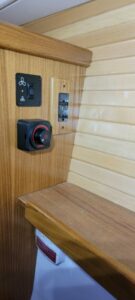
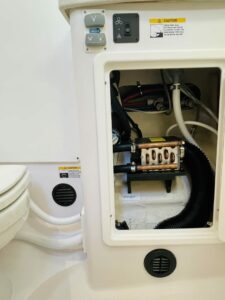
DIY or a Pro Install
“You’re going to get a very big discrepancy when it comes to installing a hydronic heater between the owner competent enough to install it themselves and a professional company,” stresses Tom. “It’s not just about having it work, but having a solid and secure system that will last the test of time. The handy boater can install a hydronic heating system on their boat, but they have to be pretty switched on because they must interface with electrical, plumbing, thru-hulls, mechanical, and then some. They also need to be comfortable running around knocking off holes through various bulkheads. Like all things marine, we recommend doing things once, and doing them right.”
Pricing
When it comes to the overall project cost, Tom stresses that every vessel is different and it depends on interior volume, heater specifications, customization, access to run the wires, plumbing and such. This makes it tough to pin down consistent numbers. “When it comes to labour times for hydronic versus forced air,” explains Tom, “labour times for a hydronic heating system are often three times as long as due to the volume of additional work required. For example, on the Catalina 445 install, the Specialty Yachts service centre ensured the installation was carried out to the highest standards. From planning, lay out, hose runs, wiring quality, and product, no expense was spared. In this case we had upwards of 150 man-hours into the installation. Vessels with full access can expect to see far less time involved. Generally, a forced air heater can be installed in two or three days, where a hydronic system can sometimes take a couple weeks.”
